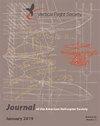Development and Whirl Flutter Test of the Maryland Tiltrotor Rig
IF 1.4
4区 工程技术
Q2 ENGINEERING, AEROSPACE
引用次数: 0
Abstract
The first whirl flutter test of the Maryland Tiltrotor Rig (MTR) was recently completed in the Naval Surface Warfare Center Carderock Division 2.44 m by 3.05 m (8- by 10-ft) large subsonic wind tunnel. The MTR is a 1.45 m (4.75-ft) diameter, three-bladed, semispan, floor-mounted, optionally powered, flutter rig. This paper describes the major features of the MTR and the results obtained from the first successful flutter tests. Parametric variations of rig features include wing profile on and off, gimbal free and gimbal locked hub, powered and freewheeling rotor, and straight and swept-tip blades. For the freewheeling rotor condition, the rotor speed is trimmed to 1050 RPM by setting blade collective. The gimbal is trimmed to zero first harmonic flapping by setting blade cyclics. Model configurations were tested up to 100 kt windspeed. The model was excited by oscillating the swashplate at the wing-pylon natural frequencies. Eight speed sweeps were carried out to acquire frequency and damping data on different model configurations. Frequency and damping of the wing beam and chord modes were extracted using the moving-block method.马里兰倾转旋翼机研制及旋翼颤振试验
马里兰倾转旋翼机(MTR)的第一次旋翼颤振试验最近在海军水面作战中心Carderock分部完成了2.44米× 3.05米(8 × 10英尺)大的亚音速风洞。地铁是1.45米(4.75英尺)直径,三叶片,半跨度,地板安装,可选的动力,颤振钻机。本文介绍了MTR的主要特点和第一次成功的颤振试验的结果。钻机功能的参数变化包括机翼轮廓的开启和关闭,无万向节和锁定万向节的轮毂,动力和自由旋转的转子,直叶和后掠叶。在自由转子状态下,通过设置叶片集体,将转子转速修剪为1050rpm。通过设置叶片周期,万向架被修剪为零次谐波扑动。模型配置进行了高达100节风速的测试。该模型是通过在翼塔固有频率下摆动斜盘来激励的。进行了8次速度扫描,以获取不同型号配置下的频率和阻尼数据。采用移动块法提取翼梁振型和弦振型的频率和阻尼。
本文章由计算机程序翻译,如有差异,请以英文原文为准。
求助全文
约1分钟内获得全文
求助全文
来源期刊

Journal of the American Helicopter Society
工程技术-工程:宇航
CiteScore
4.10
自引率
33.30%
发文量
36
审稿时长
>12 weeks
期刊介绍:
The Journal of the American Helicopter Society is a peer-reviewed technical journal published quarterly (January, April, July and October) by AHS — The Vertical Flight Society. It is the world''s only scientific journal dedicated to vertical flight technology and is available in print and online.
The Journal publishes original technical papers dealing with theory and practice of vertical flight. The Journal seeks to foster the exchange of significant new ideas and information about helicopters and V/STOL aircraft. The scope of the Journal covers the full range of research, analysis, design, manufacturing, test, operations, and support. A constantly growing list of specialty areas is included within that scope. These range from the classical specialties like aerodynamic, dynamics and structures to more recent priorities such as acoustics, materials and signature reduction and to operational issues such as design criteria, safety and reliability. (Note: semi- and nontechnical articles of more general interest reporting current events or experiences should be sent to the VFS magazine
 求助内容:
求助内容: 应助结果提醒方式:
应助结果提醒方式:


